JAJS559L September 1998 – June 2016 LM2671
PRODUCTION DATA.
- 1 特長
- 2 アプリケーション
- 3 概要
- 4 改訂履歴
- 5 Description (continued)
- 6 Pin Configuration and Functions
-
7 Specifications
- 7.1 Absolute Maximum Ratings
- 7.2 ESD Ratings
- 7.3 Recommended Operating Conditions
- 7.4 Thermal Information
- 7.5 Electrical Characteristics - 3.3 V
- 7.6 Electrical Characteristics - 5 V
- 7.7 Electrical Characteristics - 12 V
- 7.8 Electrical Characteristics - Adjustable
- 7.9 Electrical Characteristics - All Output Voltage Versions
- 7.10 Typical Characteristics
- 8 Detailed Description
-
9 Application and Implementation
- 9.1 Application Information
- 9.2 Typical Applications
- 10Power Supply Recommendations
- 11Layout
- 12デバイスおよびドキュメントのサポート
- 13メカニカル、パッケージ、および注文情報
パッケージ・オプション
メカニカル・データ(パッケージ|ピン)
サーマルパッド・メカニカル・データ
発注情報
7 Specifications
7.1 Absolute Maximum Ratings
over operating free-air temperature range (unless otherwise noted)(1)(2)| MIN | MAX | UNIT | |||
|---|---|---|---|---|---|
| Supply voltage | 45 | V | |||
| ON/OFF pin voltage, VSH | −0.1 | 6 | V | ||
| Switch voltage to ground | –1 | V | |||
| Boost pin voltage | VSW + 8 | V | |||
| Feedback pin voltage, VFB | −0.3 | 14 | V | ||
| Power dissipation | Internally Limited | ||||
| Lead temperature | D package | Vapor phase (60 s) | 215 | °C | |
| Infrared (15 s) | 220 | ||||
| P package (soldering, 10 s) | 260 | ||||
| WSON package | See AN-1187 | ||||
| Maximum junction temperature | 150 | °C | |||
| Storage temperature, Tstg | −65 | 150 | °C | ||
(1) Stresses beyond those listed under Absolute Maximum Ratings may cause permanent damage to the device. These are stress ratings only, which do not imply functional operation of the device at these or any other conditions beyond those indicated under Recommended Operating Conditions. Exposure to absolute-maximum-rated conditions for extended periods may affect device reliability.
(2) If Military/Aerospace specified devices are required, please contact the Texas Instruments Sales Office/Distributors for availability and specifications.
7.2 ESD Ratings
| VALUE | UNIT | |||
|---|---|---|---|---|
| V(ESD) | Electrostatic discharge | Human-body model (HBM), per ANSI/ESDA/JEDEC JS-001(1)(2) | ±2000 | V |
(1) JEDEC document JEP155 states that 500-V HBM allows safe manufacturing with a standard ESD control process.
(2) The human body model is a 100-pF capacitor discharged through a 1.5-kΩ resistor into each pin.
7.3 Recommended Operating Conditions
| MIN | MAX | UNIT | |
|---|---|---|---|
| Supply voltage | 6.5 | 40 | V |
| Junction temperature, TJ | –40 | 125 | °C |
7.4 Thermal Information
| THERMAL METRIC(1) | LM2674 | UNIT | |||
|---|---|---|---|---|---|
| D (SOIC) | P (PDIP) | NHN (WSON) | |||
| 8 PINS | 8 PINS | 16 PINS | |||
| RθJA | Junction-to-ambient thermal resistance(2) | 105 | 95 | — | °C/W |
(1) For more information about traditional and new thermal metrics, see the Semiconductor and IC Package Thermal Metrics application report.
(2) Junction to ambient thermal resistance with approximately 1 square inch of printed-circuit board copper surrounding the leads. Additional copper area lowers thermal resistance further. The value RθJA for the WSON (NHN) package is specifically dependent on PCB trace area, trace material, and the number of layers and thermal vias. For improved thermal resistance and power dissipation for the WSON package, see AN-1187 Leadless Leadframe Package (LLP).
7.5 Electrical Characteristics – 3.3 V
Specifications are for TJ = 25°C (unless otherwise noted).| PARAMETER | TEST CONDITIONS | MIN(3) | TYP(2) | MAX(3) | UNIT | ||
|---|---|---|---|---|---|---|---|
| SYSTEM PARAMETERS(1) | |||||||
| VOUT | Output voltage | VIN = 8 V to 40 V, ILOAD = 20 mA to 500 mA |
TJ = 25°C | 3.251 | 3.3 | 3.35 | V |
| Over full operating temperature range | 3.201 | 3.399 | |||||
| VIN = 6.5 V to 40 V, ILOAD = 20 mA to 250 mA |
TJ = 25°C | 3.251 | 3.3 | 3.35 | V | ||
| Over full operating temperature range | 3.201 | 3.399 | |||||
| η | Efficiency | VIN = 12 V, ILOAD = 500 mA | 86% | ||||
(1) External components such as the catch diode, inductor, input and output capacitors, and voltage programming resistors can affect switching regulator performance. When the LM2671 is used as shown in Figure 15 and Figure 21 test circuits, system performance is as specified by the system parameters section of the Electrical Characteristics.
(2) Typical numbers are at 25°C and represent the most likely norm.
(3) All room temperature limits are 100% production tested. All limits at temperature extremes are ensured through correlation using standard Statistical Quality Control (SQC) methods. All limits are used to calculate Average Outgoing Quality Level (AOQL).
7.6 Electrical Characteristics – 5 V
Specifications are for TJ = 25°C (unless otherwise noted).| PARAMETER | TEST CONDITIONS | MIN(3) | TYP(2) | MAX(3) | UNIT | ||
|---|---|---|---|---|---|---|---|
| SYSTEM PARAMETERS(1) | |||||||
| VOUT | Output voltage | VIN = 8 V to 40 V, ILOAD = 20 mA to 500 mA |
TJ = 25°C | 4.925 | 5 | 5.075 | V |
| Over full operating temperature range | 4.85 | 5.15 | |||||
| VIN = 6.5 V to 40 V, ILOAD = 20 mA to 250 mA |
TJ = 25°C | 4.925 | 5 | 5.075 | V | ||
| Over full operating temperature range | 4.85 | 5.15 | |||||
| η | Efficiency | VIN = 12 V, ILOAD = 500 mA | 90% | ||||
(1) External components such as the catch diode, inductor, input and output capacitors, and voltage programming resistors can affect switching regulator performance. When the LM2671 is used as shown in Figure 15 and Figure 21 test circuits, system performance is as specified by the system parameters section of the Electrical Characteristics.
(2) Typical numbers are at 25°C and represent the most likely norm.
(3) All room temperature limits are 100% production tested. All limits at temperature extremes are ensured through correlation using standard Statistical Quality Control (SQC) methods. All limits are used to calculate Average Outgoing Quality Level (AOQL).
7.7 Electrical Characteristics – 12 V
Specifications are for TJ = 25°C (unless otherwise noted).| PARAMETER | TEST CONDITIONS | MIN(3) | TYP(2) | MAX(3) | UNIT | ||
|---|---|---|---|---|---|---|---|
| SYSTEM PARAMETERS(1) | |||||||
| VOUT | Output voltage | VIN = 15 V to 40 V, ILOAD = 20 mA to 500 mA |
TJ = 25°C | 11.82 | 12 | 12.18 | V |
| Over full operating temperature range | 11.64 | 12.36 | |||||
| η | Efficiency | VIN = 24 V, ILOAD = 500 mA | 94% | ||||
(1) External components such as the catch diode, inductor, input and output capacitors, and voltage programming resistors can affect switching regulator performance. When the LM2671 is used as shown in Figure 15 and Figure 21 test circuits, system performance is as specified by the system parameters section of the Electrical Characteristics.
(2) Typical numbers are at 25°C and represent the most likely norm.
(3) All room temperature limits are 100% production tested. All limits at temperature extremes are ensured through correlation using standard Statistical Quality Control (SQC) methods. All limits are used to calculate Average Outgoing Quality Level (AOQL).
7.8 Electrical Characteristics – Adjustable
Specifications are for TJ = 25°C (unless otherwise noted).| PARAMETER | TEST CONDITIONS | MIN(3) | TYP(2) | MAX(3) | UNIT | ||
|---|---|---|---|---|---|---|---|
| SYSTEM PARAMETERS(1) | |||||||
| VFB | Feedback voltage | VIN = 8 V to 40 V, ILOAD = 20 mA to 500 mA VOUT programmed for 5 V |
TJ = 25°C | 1.192 | 1.21 | 1.228 | V |
| Over full operating temperature range | 1.174 | 1.246 | |||||
| VIN = 6.5 V to 40 V, ILOAD = 20 mA to 250 mA VOUT programmed for 5 V |
TJ = 25°C | 1.192 | 1.21 | 1.228 | V | ||
| Over full operating temperature range | 1.174 | 1.246 | |||||
| η | Efficiency | VIN = 12 V, ILOAD = 500 mA | 90% | ||||
(1) External components such as the catch diode, inductor, input and output capacitors, and voltage programming resistors can affect switching regulator performance. When the LM2671 is used as shown in Figure 15 and Figure 21 test circuits, system performance is as specified by the system parameters section of the Electrical Characteristics.
(2) Typical numbers are at 25°C and represent the most likely norm.
(3) All room temperature limits are 100% production tested. All limits at temperature extremes are ensured through correlation using standard Statistical Quality Control (SQC) methods. All limits are used to calculate Average Outgoing Quality Level (AOQL).
7.9 Electrical Characteristics – All Output Voltage Versions
Specifications are for TJ = 25°C, VIN = 12 V for the 3.3-V, 5-V, and Adjustable versions and VIN = 24 V for the 12-V version, and ILOAD = 100 mA (unless otherwise noted).| PARAMETERS | TEST CONDITIONS | MIN | TYP | MAX | UNIT | ||
|---|---|---|---|---|---|---|---|
| DEVICE PARAMETERS | |||||||
| IQ | Quiescent current | VFEEDBACK = 8 V for 3.3-V, 5-V, and adjustable versions |
2.5 | 3.6 | mA | ||
| VFEEDBACK = 15 V for 12-V versions |
2.5 | ||||||
| ISTBY | Standby quiescent current | ON/OFF pin = 0 V | TJ = 25°C | 50 | 100 | μA | |
| Over full operating temperature range | 150 | ||||||
| ICL | Current limit | TJ = 25°C | 0.62 | 0.8 | 1.2 | A | |
| Over full operating temperature range | 0.575 | 1.25 | |||||
| IL | Output leakage current | VIN = 40 V, ON/OFF pin = 0 V VSWITCH = 0 V |
1 | 25 | μA | ||
| VSWITCH = −1 V, ON/OFF pin = 0 V | 6 | 15 | mA | ||||
| RDS(ON) | Switch ON-resistance | ISWITCH = 500 mA | TJ = 25°C | 0.25 | 0.4 | Ω | |
| Over full operating temperature range | 0.6 | ||||||
| fO | Oscillator frequency | Measured at switch pin | TJ = 25°C | 260 | kHz | ||
| Over full operating temperature range | 225 | 275 | |||||
| D | Maximum duty cycle | 95% | |||||
| Minimum duty cycle | 0% | ||||||
| IBIAS | Feedback bias current | VFEEDBACK = 1.3 V (adjustable version only) | 85 | nA | |||
| VS/D | ON/OFF pin voltage thresholds | TJ = 25°C | 1.4 | V | |||
| Over full operating temperature range | 0.8 | 2 | |||||
| IS/D | ON/OFF pin current | ON/OFF pin = 0 V | TJ = 25°C | 20 | μA | ||
| Over full operating temperature range | 7 | 37 | |||||
| FSYNC | Synchronization frequency | VSYNC = 3.5 V, 50% duty cycle | 400 | kHz | |||
| VSYNC | Synchronization threshold voltage | 1.4 | V | ||||
| VSS | Soft-start voltage | TJ = 25°C | 0.63 | V | |||
| Over full operating temperature range | 0.53 | 0.73 | |||||
| ISS | Soft-start current | TJ = 25°C | 4.5 | μA | |||
| Over full operating temperature range | 1.5 | 6.9 | |||||
7.10 Typical Characteristics
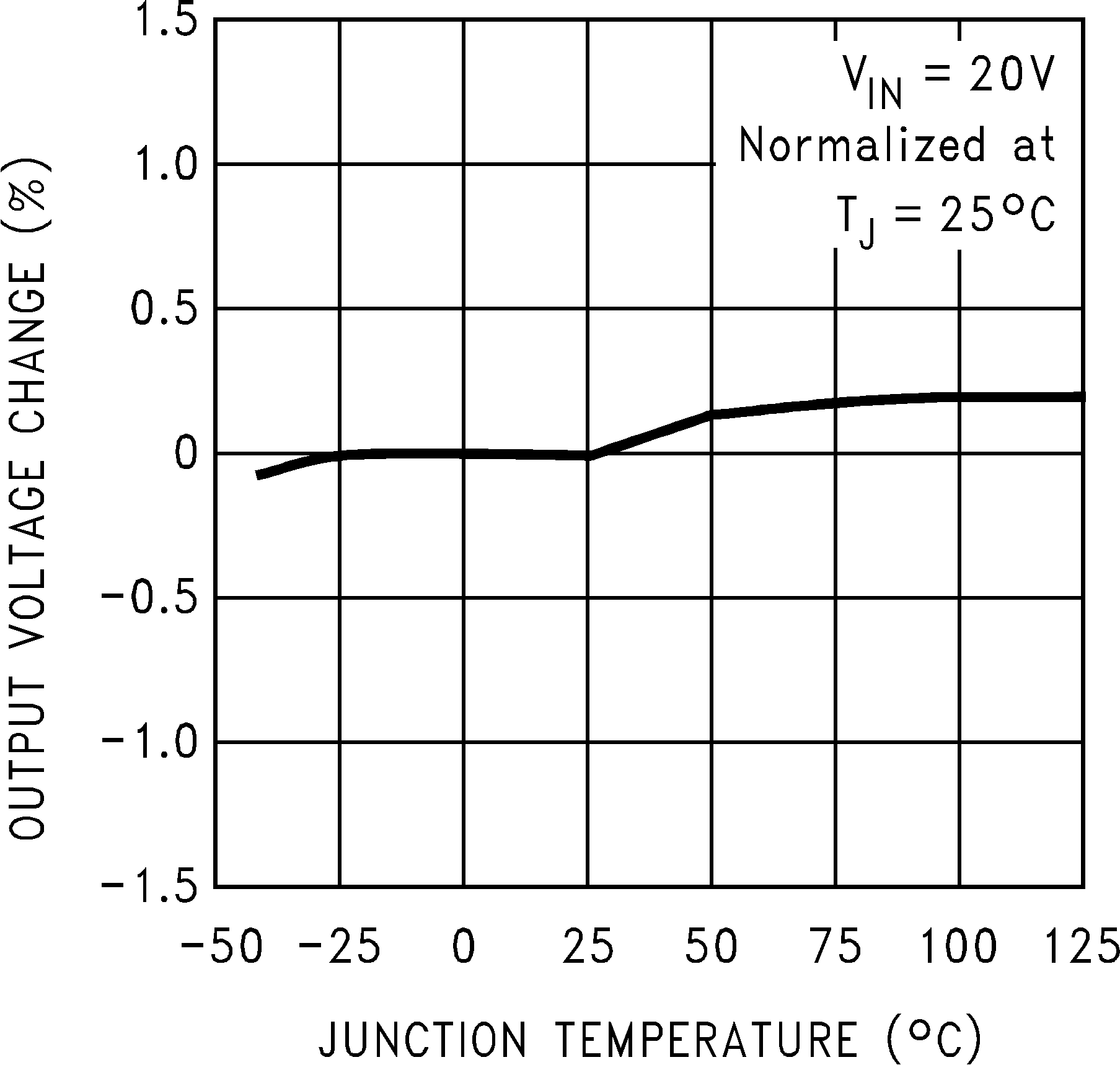 Figure 1. Normalized Output Voltage
Figure 1. Normalized Output Voltage
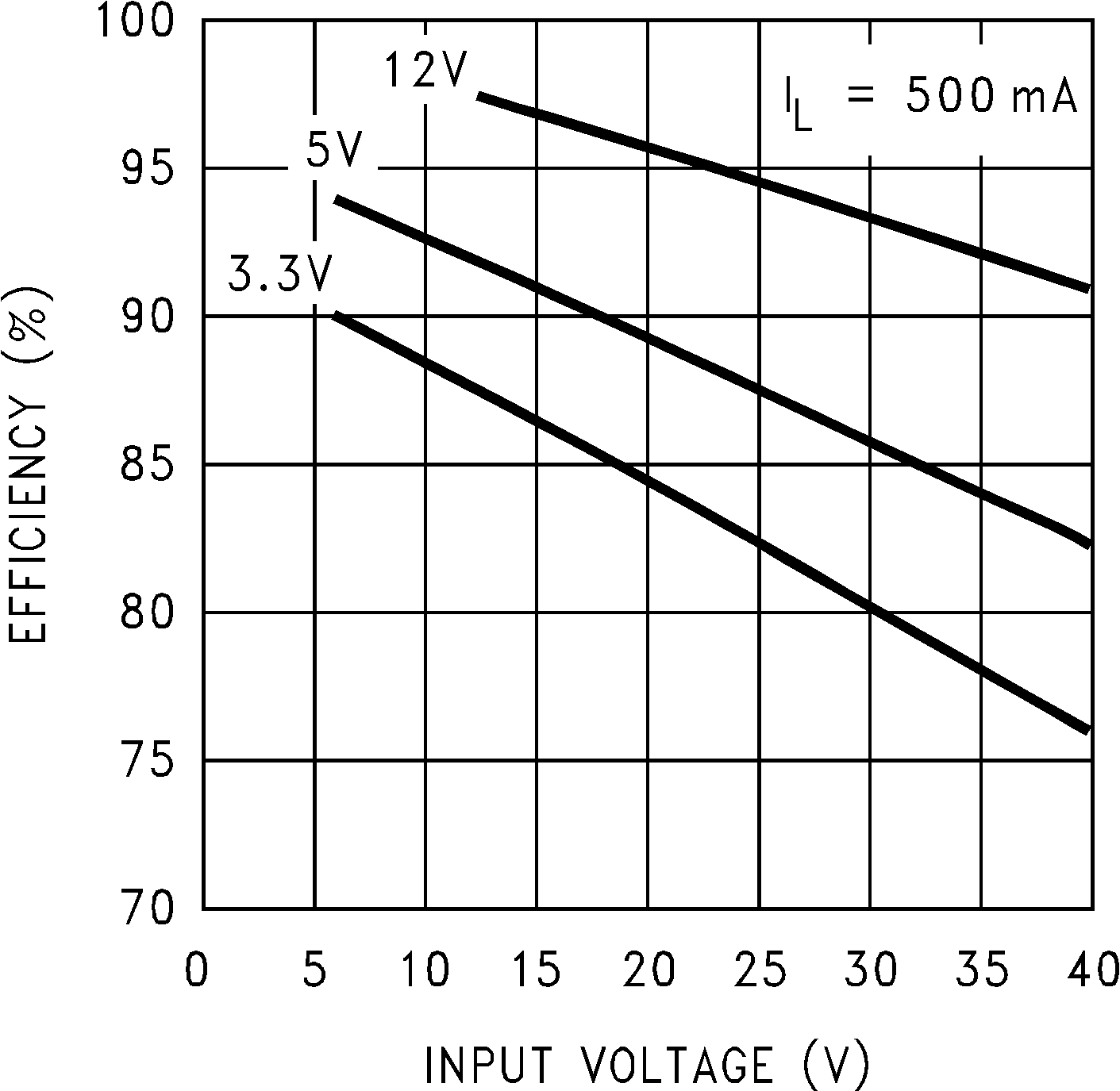 Figure 3. Efficiency
Figure 3. Efficiency
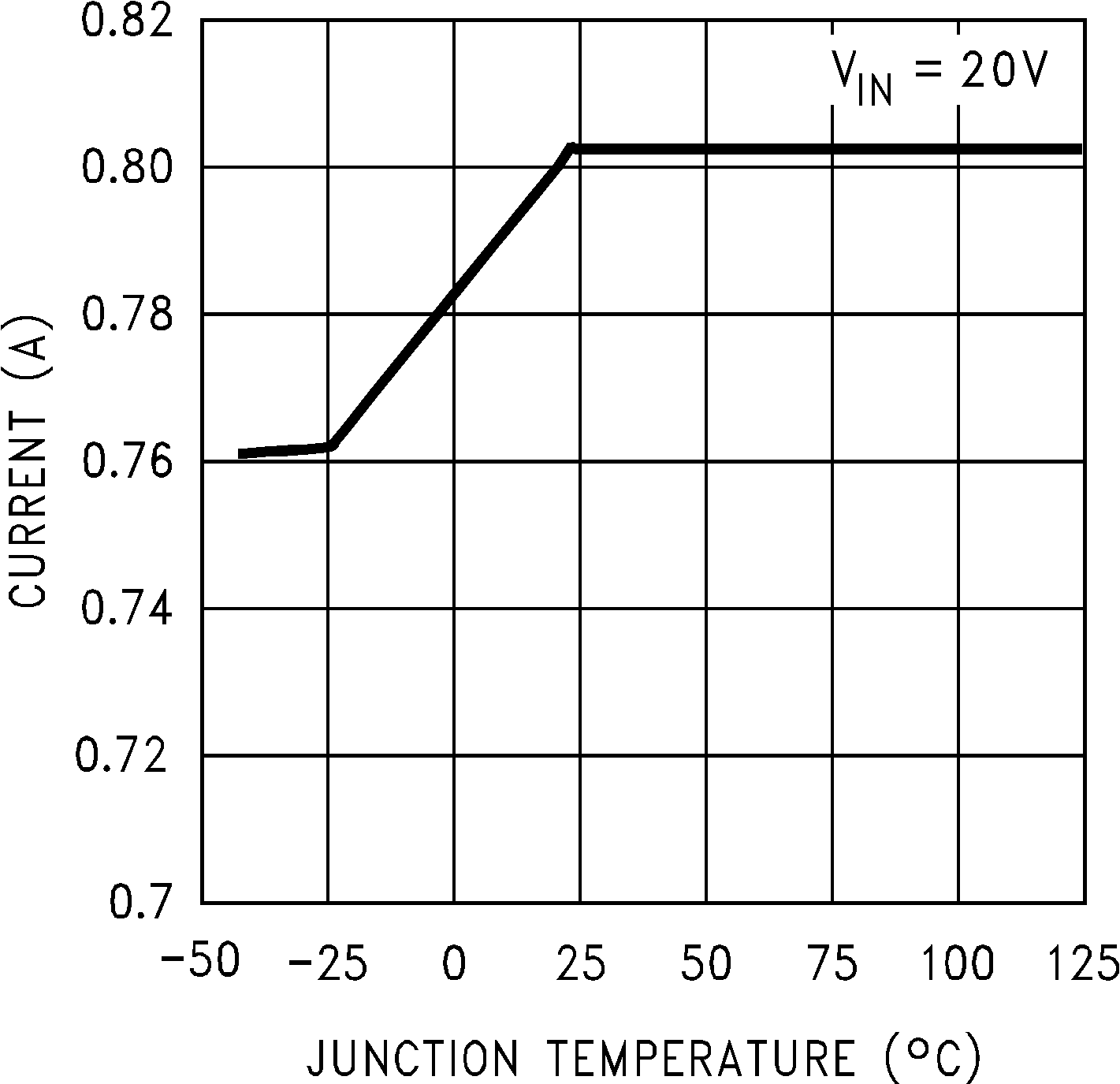 Figure 5. Switch Current Limit
Figure 5. Switch Current Limit
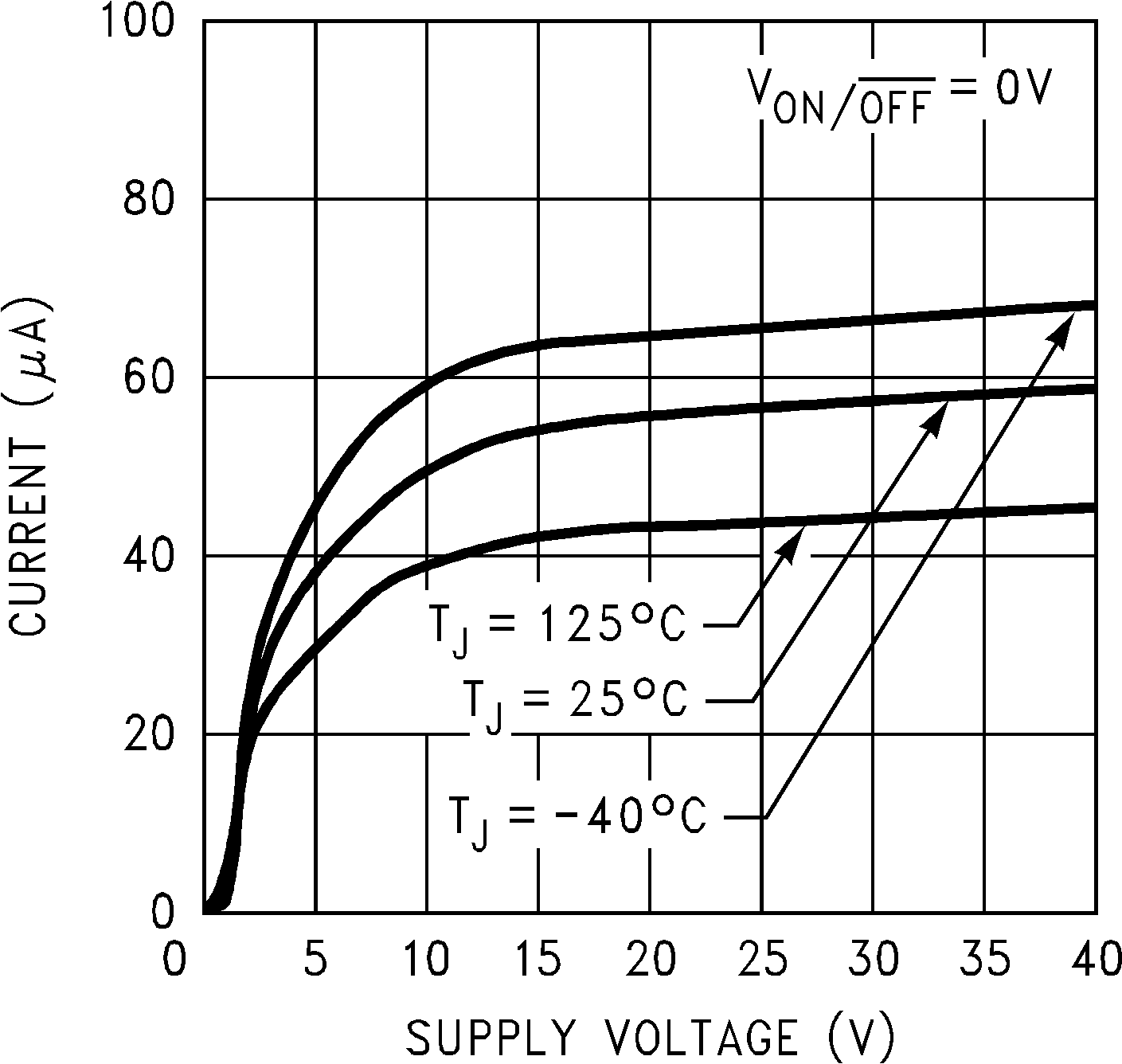 Figure 7. Standby Quiescent Current
Figure 7. Standby Quiescent Current
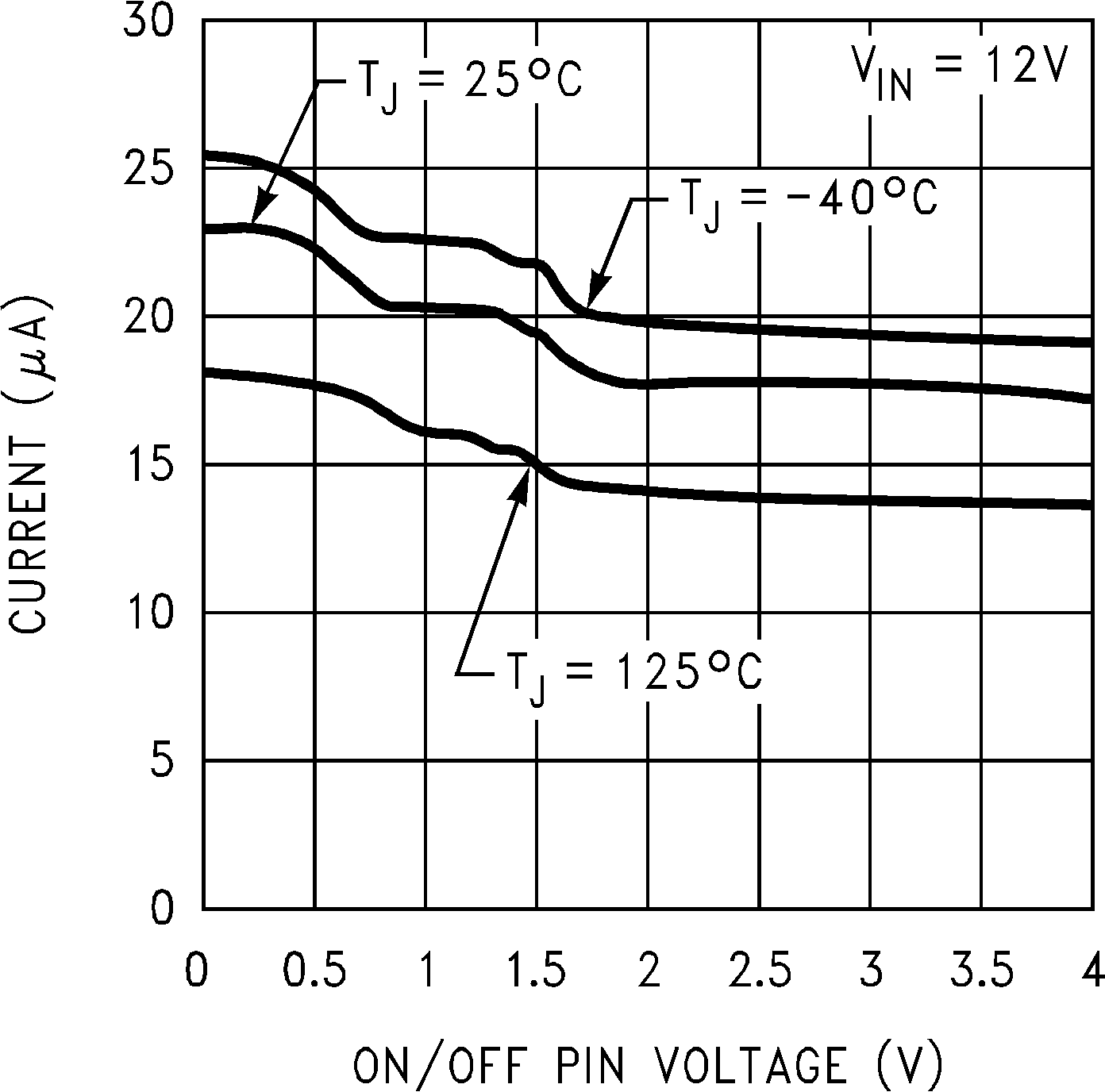 Figure 9. ON/OFF Pin Current (Sourcing)
Figure 9. ON/OFF Pin Current (Sourcing)
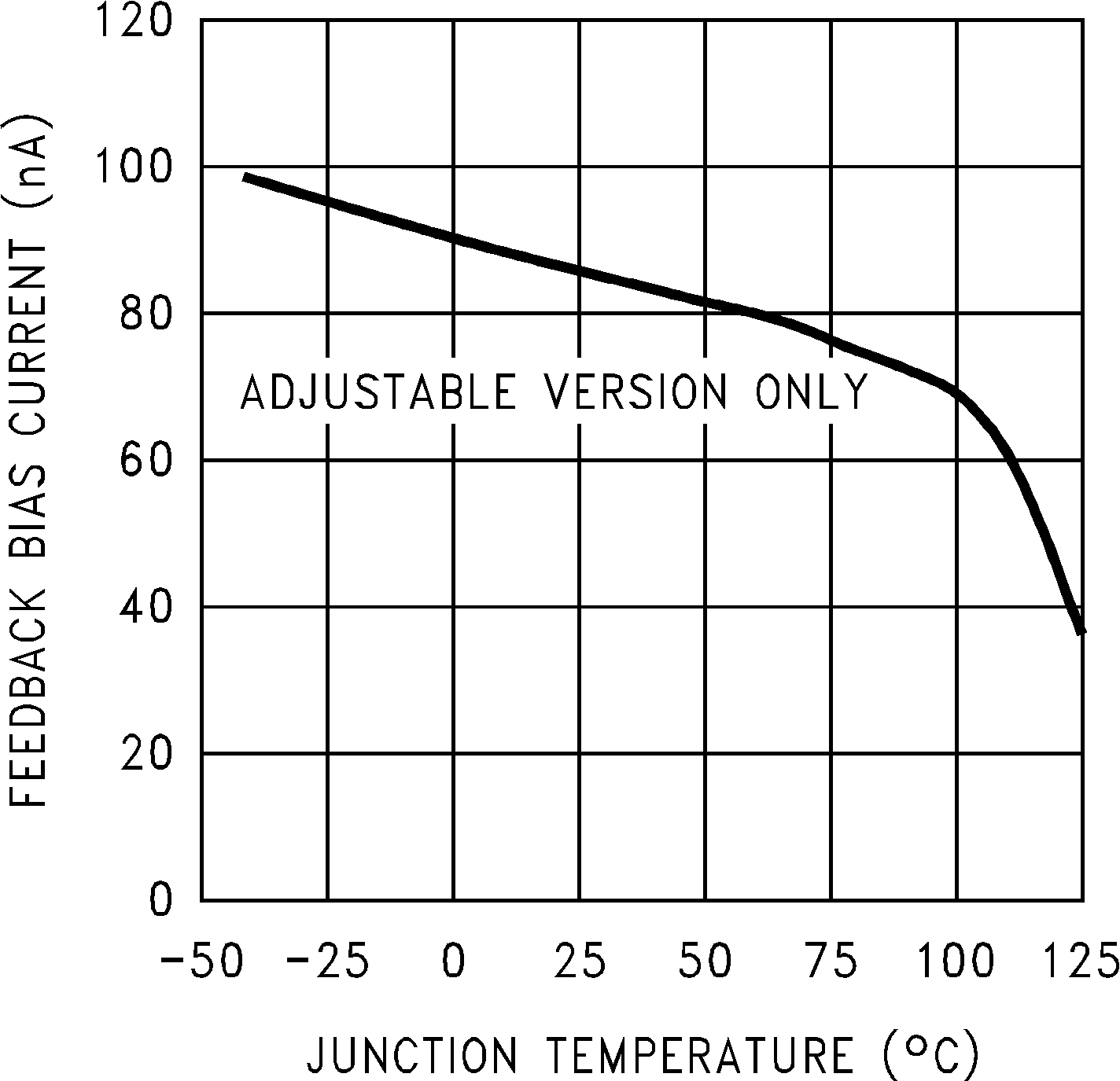 Figure 11. Feedback Pin Bias Current
Figure 11. Feedback Pin Bias Current
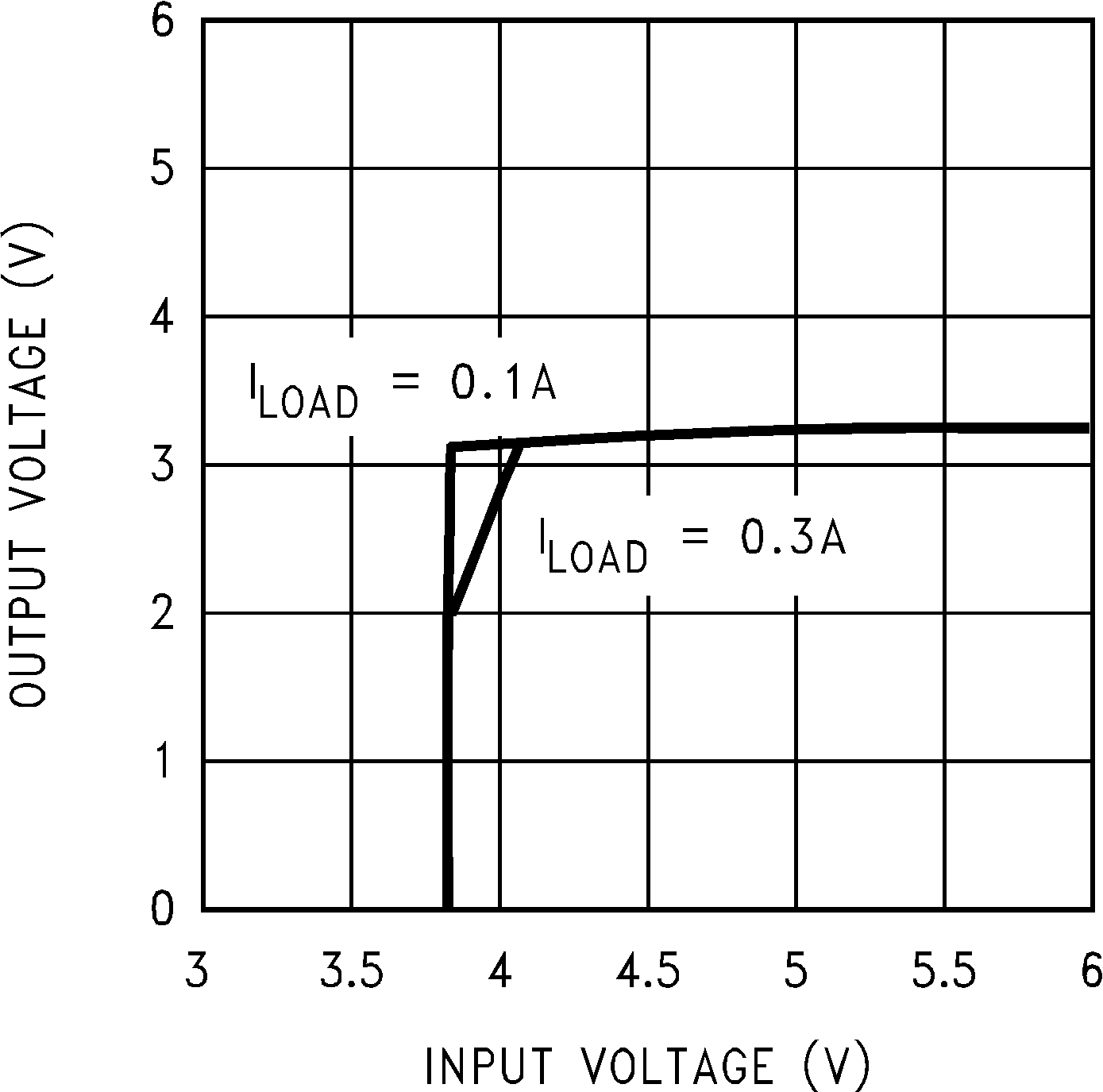 Figure 13. Dropout Voltage – 3.3-V Option
Figure 13. Dropout Voltage – 3.3-V Option
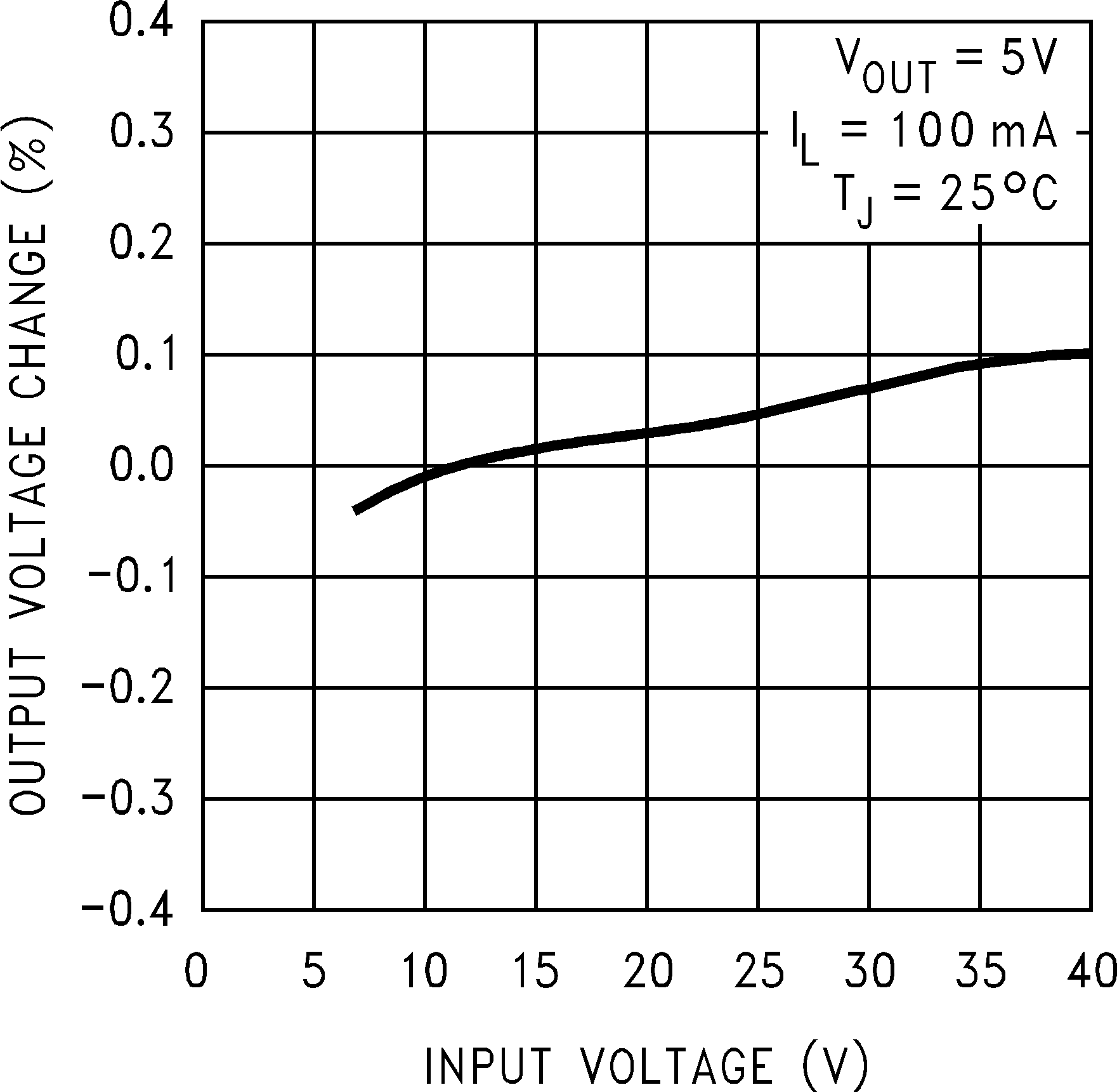 Figure 2. Line Regulation
Figure 2. Line Regulation
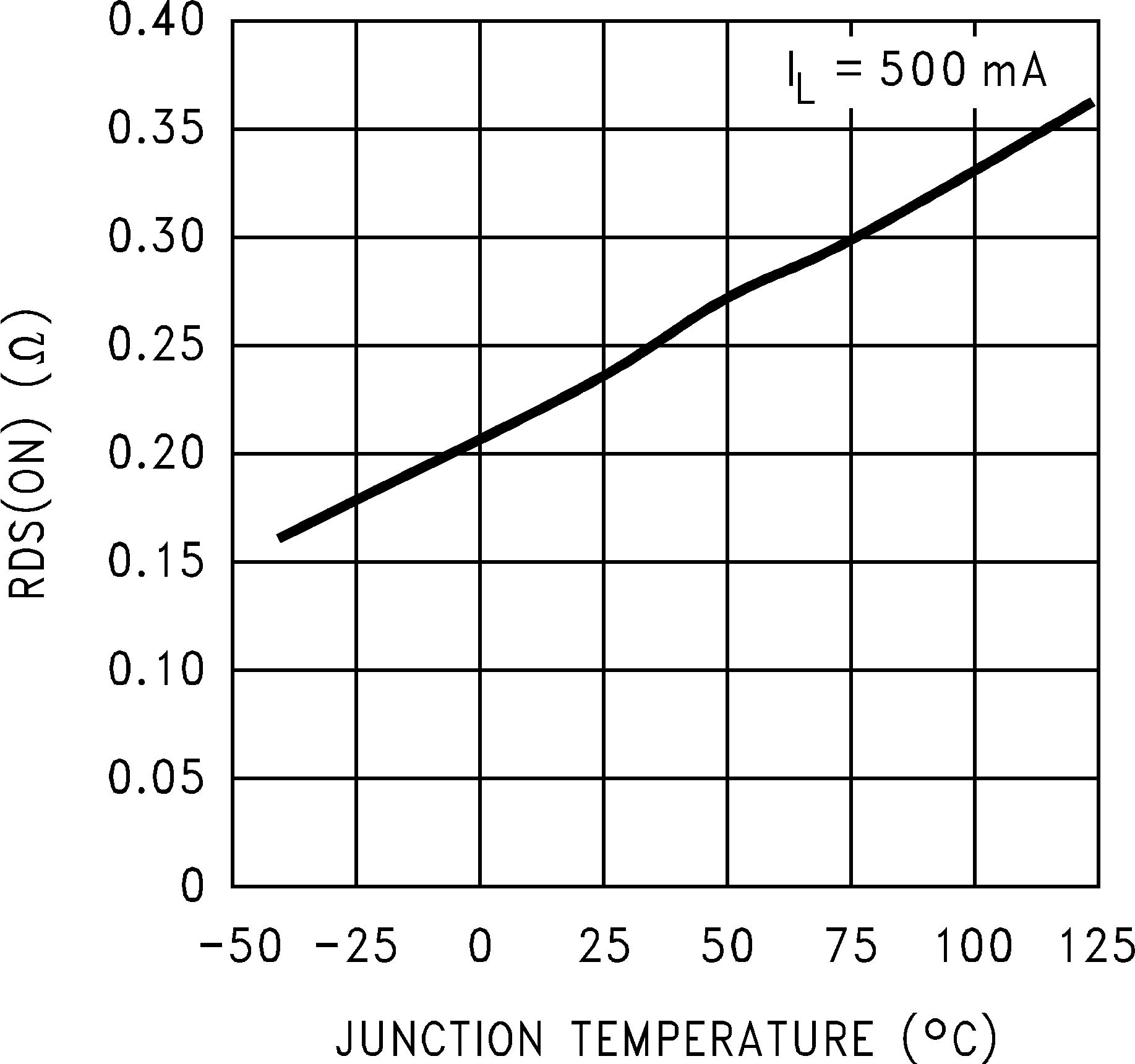 Figure 4. Drain-to-Source Resistance
Figure 4. Drain-to-Source Resistance
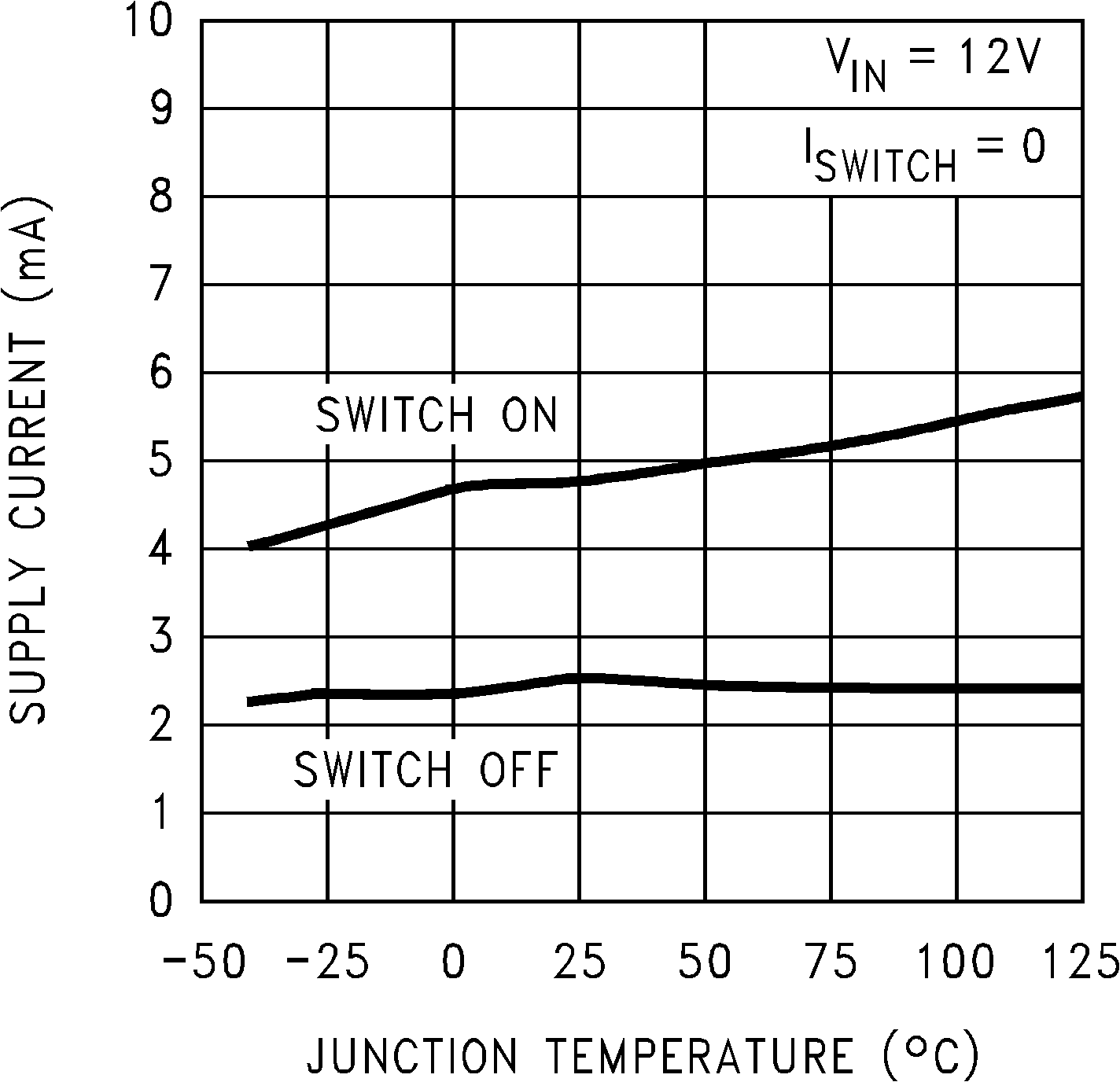 Figure 6. Operating Quiescent Current
Figure 6. Operating Quiescent Current
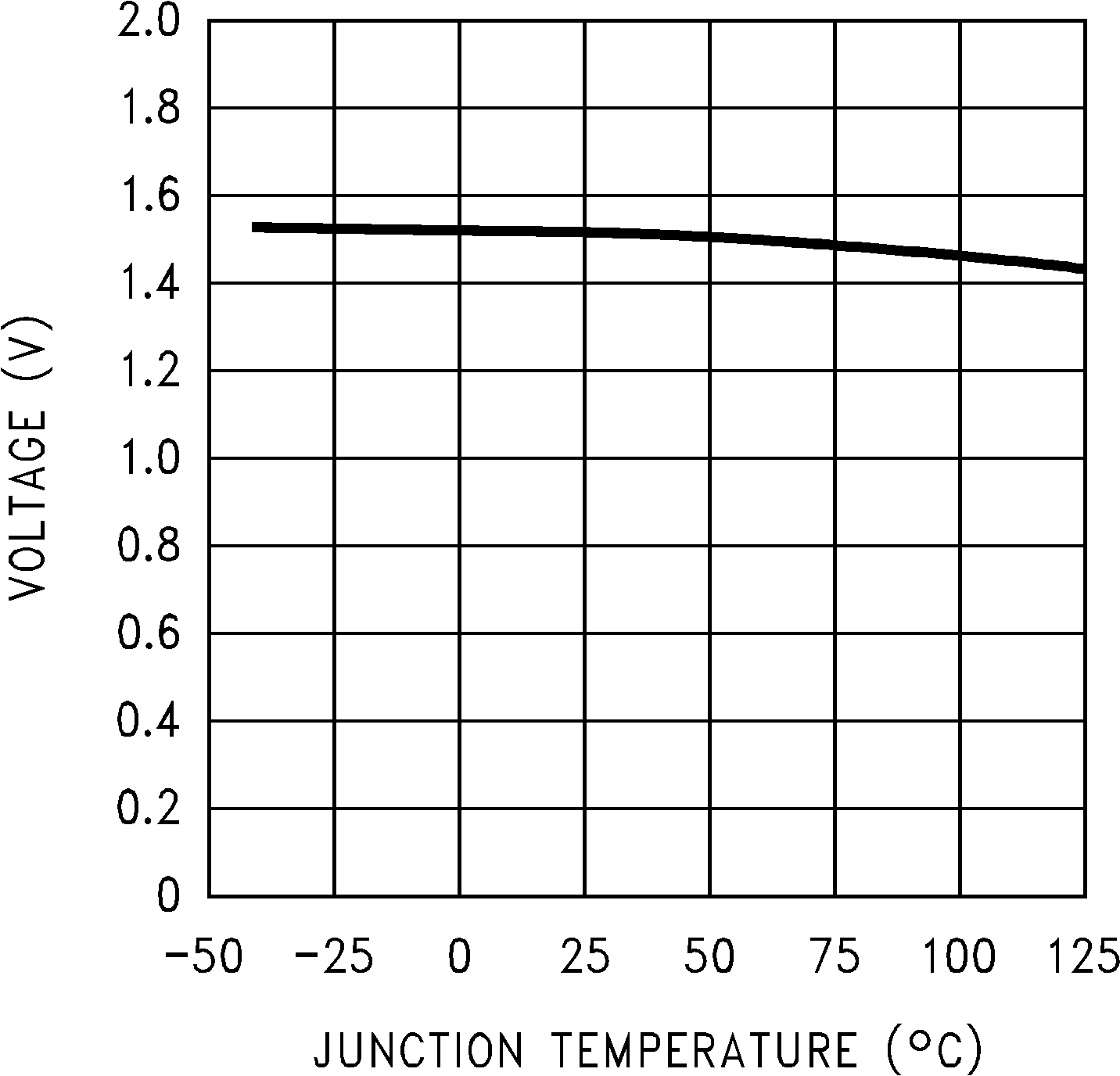 Figure 8. ON/OFF Threshold Voltage
Figure 8. ON/OFF Threshold Voltage
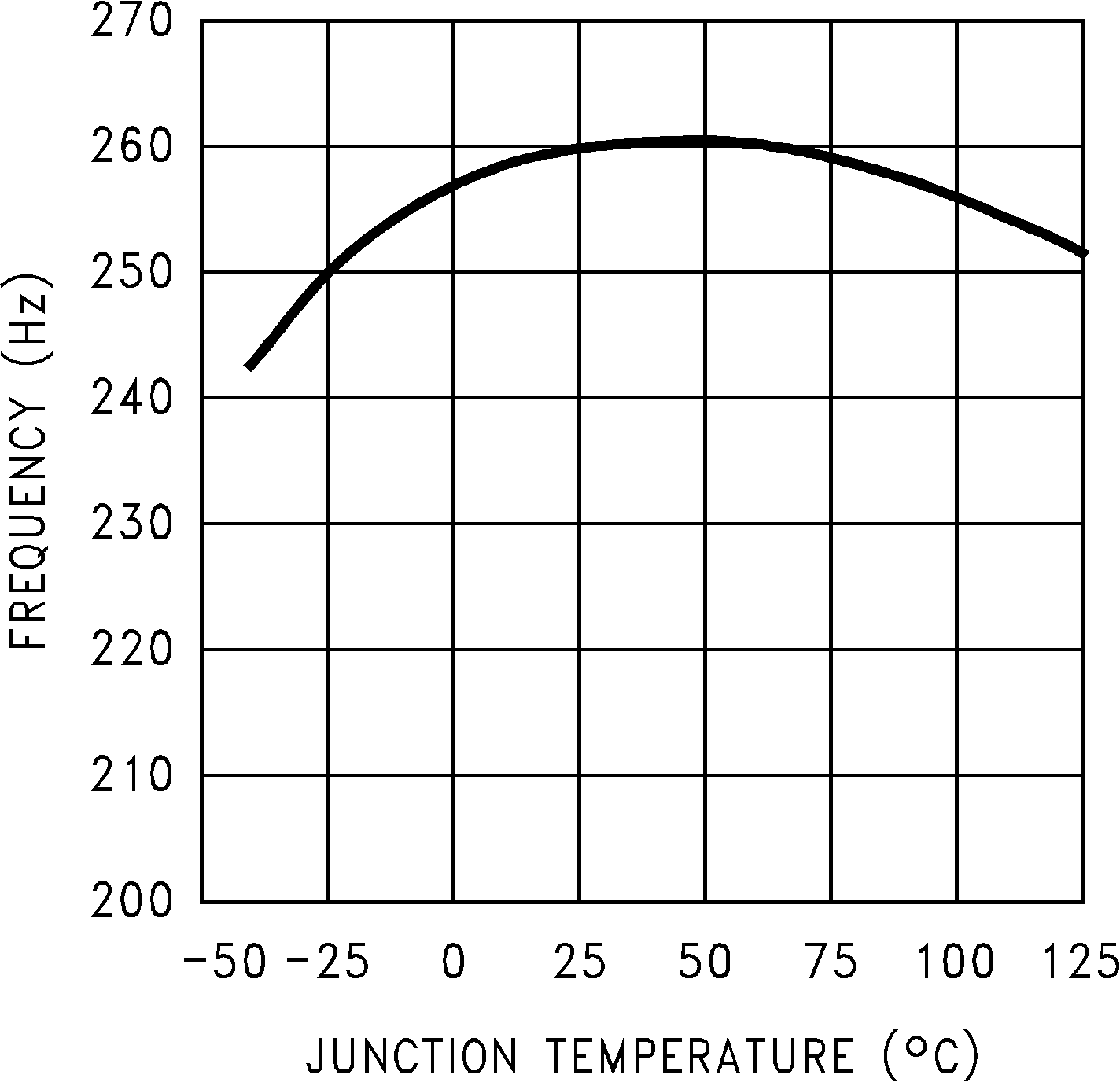 Figure 10. Switching Frequency
Figure 10. Switching Frequency
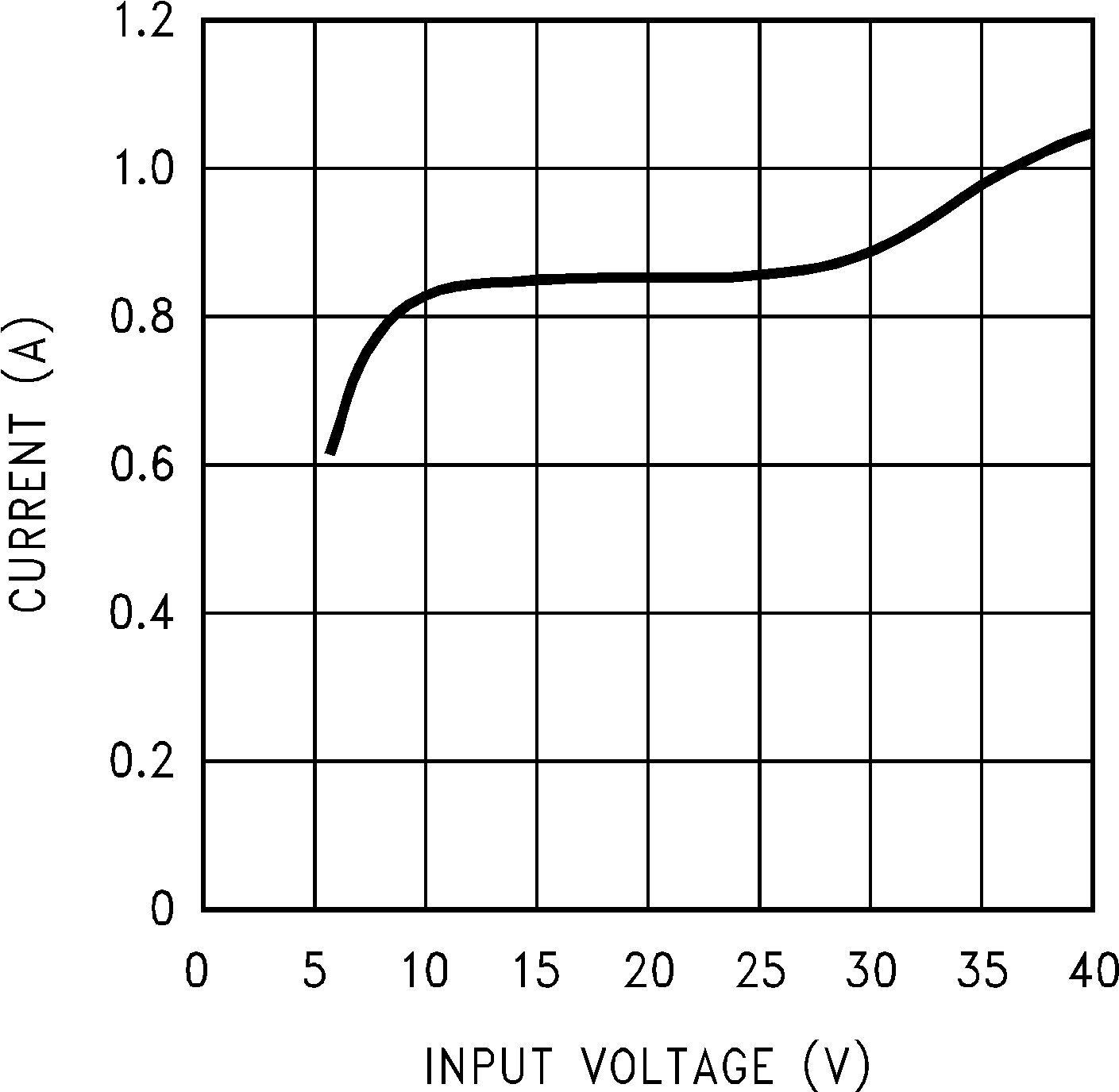 Figure 12. Peak Switch Current
Figure 12. Peak Switch Current
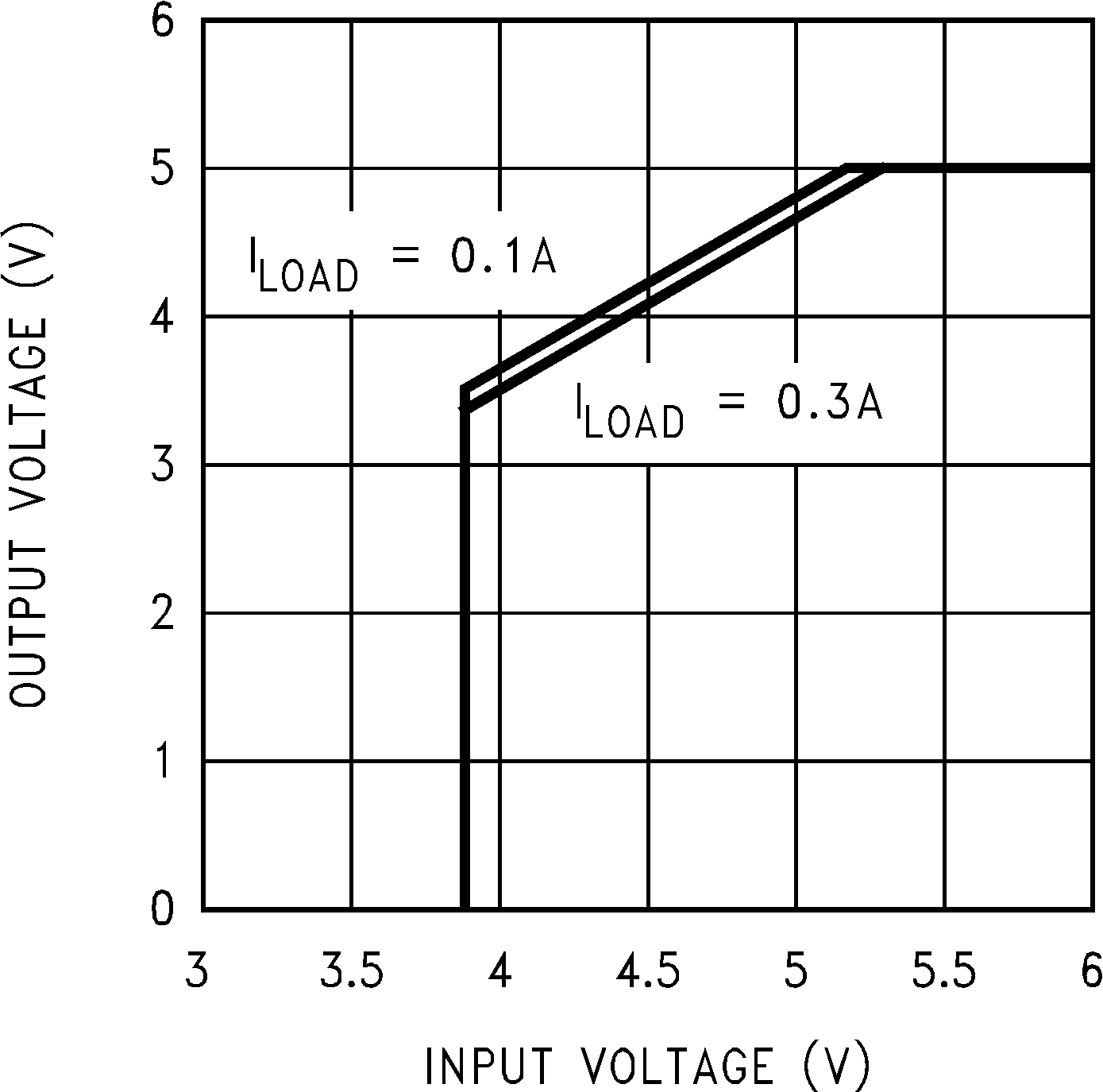 Figure 14. Dropout Voltage – 5-V Option
Figure 14. Dropout Voltage – 5-V Option